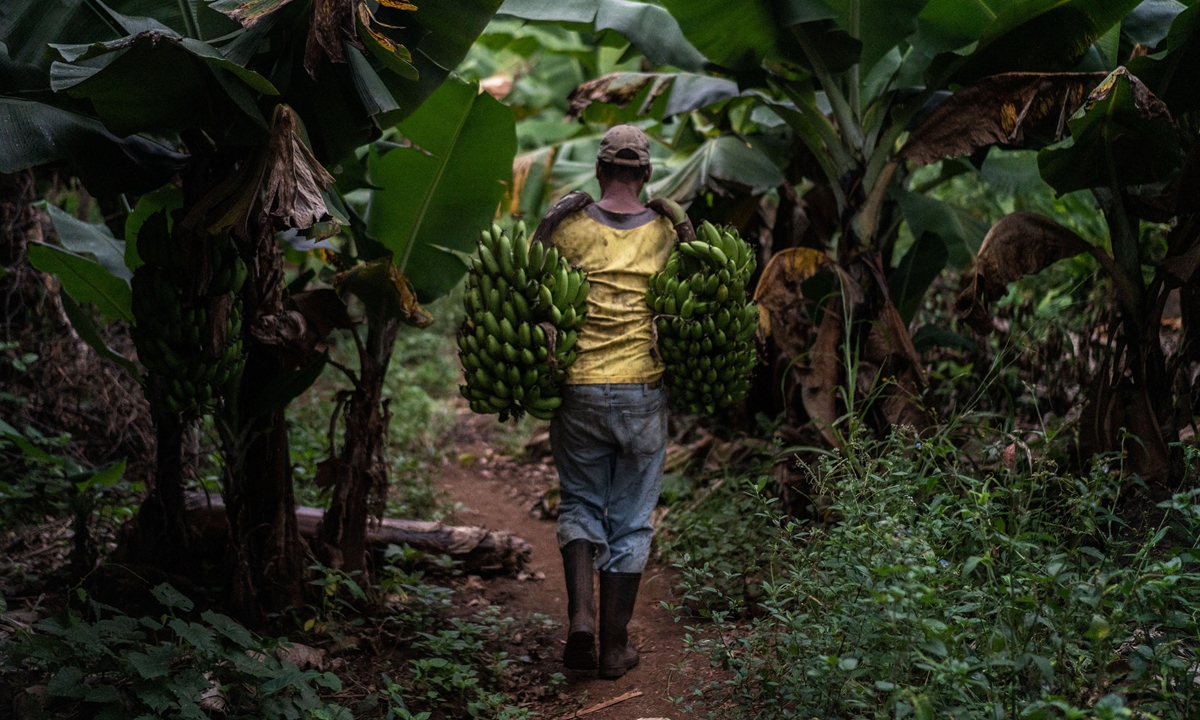
A man carries bananas that he collected at a farm in Taita Taveta, Kenya. File photo: AFP
Sandwiched between rolling hills which dot the southeastern Kenyan county of Taita Taveta, the Ngangao forest has often been described as a natural wonder interwoven with the heritage of local communities.
Adjacent to the vast indigenous forest is a serene village where Nathaniel Mwambisi grew up hearing fabled tales of the forest.
Now aged 28, Mwambisi and his peers are on the frontline of reclaiming a biodiversity hot spot intertwined with the survival of local small-holder farmers, having watched it undergo some human-induced degradation.
The youth is a founder member of Dawida Biodiversity Conservation Group, a grassroots-based green lobby that has pioneered efforts to restore Ngangao forest to its original luster.
"By protecting one of the most vital indigenous forests in upper parts of coastal Kenya, we are convinced that provision of ecosystem services like fresh water and temperature moderation will be sustained," Mwambisi told Xinhua in a recent interview.
Founded in 2011, the Dawida Biodiversity Conservation Group has a membership of hundreds of youth drawn from the vast Taita Taveta County, home to the world-famous Tsavo national park.
According to Mwambisi, his peers decided to take up conservation projects around the forest after witnessing its health decline rapidly due to illegal logging and encroachment.
Unregulated harvesting of timber and charcoal burning were also decimating the Ngangao forest, posing an existential threat to the survival of local farmers who depend on it for the provision of clean water and pollination of their crops, said Mwambisi.
He added that local youth have established innovative conservation projects like indigenous tree nurseries, butterfly farming, bee-keeping and ecotourism which provide alternative livelihoods and dissuade farmers from unsustainable exploitation of its resources.
Indigenous forests rich in flora and fauna are a common feature in the undulating Taita hills, often described as critical water towers that sustain millions of livelihoods in southeastern Kenya and the coastal region.
The forested landscapes which extend to neighboring Tanzania are home to Kenya's most threatened bird species, trees, medicinal herbs, butterflies, and porcupines, said Chemuku Wekesa, a landscape ecologist at the Kenya Forestry Research Institute.
Wekesa said that having been a repository of rich biodiversity including native trees, medicinal herbs, reptiles, birds and insects, the Ngangao forest is key to sustaining food, water, energy and health security of local communities.
In addition, Wekesa said the coastal biodiversity hot spot has always acted as a strong buffer against extreme weather events like droughts, floods, and heat waves, linked to the climate crisis unfolding in Kenya and neighboring Tanzania.
"So this rich biodiverse landscape is crucial for climate moderation, provision of rainfall and clean air to surrounding communities. Its preservation is key to sustainable livelihoods in the wider coastal region," said Wekesa.
As for Nathaniel Mkombola, a 43-year-old founding member of Dawida Biodiversity Conservation Group, restoring the original splendor of Ngangao forest is one mission he has taken up with gusto.
While growing up in a farming village adjacent to the indigenous forest, Mkombola used to marvel at its alluring greenery that had diminished over the years due to reckless human actions.
The middle-aged eco-warrior said that reclaiming the Ngangao forest through planting additional native tree species and pushing for the enactment of legislation to deter encroachers is paying dividends.
Mkombola said that courtesy of conservation efforts led by local youth, some degraded sections of Ngangao forest have been reclaimed, making it an attractive destination for local and foreign nature lovers.
"We are generating income from bee-keeping, butterfly farming and selling of tree seedlings to local farmers," said Mkombola.
"Even foreign researchers are descending here to partner with us and study the forest's unique native species. Groups that often camp in this forest are also generating income to support conservation work," he added.
Godwin Kowero, executive secretary of the African Forest Forum noted that the future of habitat conservation in Kenya lies in tapping the ingenuity of its youthful demographic.
Kowero said that governments should develop policy and regulatory incentives that encourage the youth to venture into forest conservation to earn decent incomes and hasten the green transition.
Xinhua




